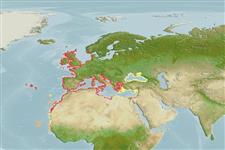Common names from other countries
Environment: milieu / climate zone / depth range / distribution range
Ecologie
marien; zoet water; brak water demersaal; amfidroom (Ref. 46888); diepte 0 - 15 m (Ref. 45332). Subtropical; 8°C - 24°C (Ref. 4944); 60°N - 12°N, 32°W - 42°E
Eastern Atlantic: western Scotland to Senegal. Also known from the Mediterranean and Black Sea. Indian Ocean: as lessepsian migrant in the Gulf of Eilat and Red Sea (Ref. 5299). Records from Pointe Noire and vicinity might be doubtful.
Lengte bij maturiteit / Grootte / Gewicht / Leeftijd
Maturity: Lm 6.5, range 6 - 7 cm
Max length : 13.0 cm TL mannelijk / geslacht onbekend; (Ref. 49698); max. gerapporteerde leeftijd: 10 Jaren (Ref. 35388)
Neck naked. No black spots in the front end of each dorsal fin (Ref. 35388).
Predominantly marine, but may enter freshwater. Adults occur inshore in intertidal waters, under stones and in pools on sheltered rocky shores with much weed cover. Macrobenthos feeder on hard substrates (Ref. 92840), they feed on crustaceans (larger amphipods, isopods, small crabs) and polychaetes; juveniles eat harpacticoid copepods, amphipods, polychaetes and mites (Ref. 4696). Oviparous (Ref. 205). Fusiform shaped eggs are found in patches of several thousand on undersurface of stones, shells, polychaete tubes or Ciona mantles (Ref. 4696).
Oviparous (Ref. 205). Male guards the eggs deposited by the female under rocks or inside empty bivalve shells until they hatch (Ref. 45332). Larvae remain near the substrate until they assume the cryptobenthic behavior of the adults (Ref. 45332). Are repeat spawners (Ref. 4696).
Maugé, L.A., 1986. Gobiidae. p. 358-388. In J. Daget, J.-P. Gosse and D.F.E. Thys van den Audenaerde (eds.) Check-list of the freshwater fishes of Africa (CLOFFA). ISNB, Brussels; MRAC, Tervuren; and ORSTOM, Paris. Vol. 2. (Ref. 4343)
Status op de Rode Lijst van het IUCN (Ref. 130435)
CITES (Ref. 128078)
Not Evaluated
Gevaar voor de mens
Harmless
Gebruik door de mens
Visserij: van minder commercieel belang; Aquarium: Publieke aquaria
Tools
Speciale rapporten
Download XML
Internetbronnen
Estimates based on models
Preferred temperature (Ref.
115969): 9.8 - 20.2, mean 17.7 (based on 823 cells).
Fylogenetische diversiteitsindex (Ref.
82804): PD
50 = 0.5000 [Uniqueness, from 0.5 = low to 2.0 = high].
Bayesian length-weight: a=0.00871 (0.00672 - 0.01128), b=3.10 (3.06 - 3.14), in cm Total Length, based on LWR estimates for this species (Ref.
93245).
Trofisch niveau (Ref.
69278): 3.3 ±0.45 se; based on food items.
Weerstandsvermogen (Ref.
120179): Gemiddeld, minimale populatieverdubbelingstijd 1,4-4,4 jaar (K=0.41; tm=0-3; tmax=10; Fec=1,054).
Fishing Vulnerability (Ref.
59153): Low vulnerability (19 of 100).
